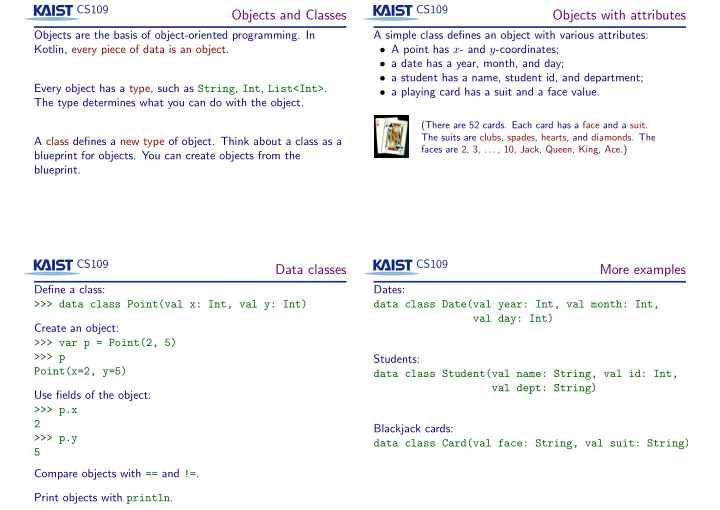

CS109 CS109 Objects and Classes Objects with attributes Objects are the basis of object-oriented programming. In A simple class defines an object with various attributes: Kotlin, every piece of data is an object. • A point has x - and y -coordinates; • a date has a year, month, and day; • a student has a name, student id, and department; Every object has a type, such as String , Int , List<Int> . • a playing card has a suit and a face value. The type determines what you can do with the object. (There are 52 cards. Each card has a face and a suit. The suits are clubs, spades, hearts, and diamonds. The A class defines a new type of object. Think about a class as a faces are 2, 3, . . . , 10, Jack, Queen, King, Ace.) blueprint for objects. You can create objects from the blueprint. CS109 CS109 Data classes More examples Define a class: Dates: >>> data class Point(val x: Int, val y: Int) data class Date(val year: Int, val month: Int, val day: Int) Create an object: >>> var p = Point(2, 5) >>> p Students: Point(x=2, y=5) data class Student(val name: String, val id: Int, val dept: String) Use fields of the object: >>> p.x 2 Blackjack cards: >>> p.y data class Card(val face: String, val suit: String) 5 Compare objects with == and != . Print objects with println .
CS109 CS109 Mutable and immutable objects The dangers of mutable objects If the state of an object cannot change after the object has What is the value of p after the following code? been constructed, it is immutable. In Kotlin, String , List , >>> val p = MPoint(3, 5) pairs, and triples are immutable. >>> val q = p >>> q.x = 7 The data classes defined before are all immutable. >>> q If the state of an object can change, it is mutable. MPoint(x=7, y=5) MutableList objects are mutable objects. A mutable case class for two-dimensional points: data class MPoint(var x: Int, var y: Int) >>> p >>> val p = MPoint(5, 3) MPoint(x=7, y=5) >>> p MPoint(x=5, y=3) >>> p.x = 7 >>> p MPoint(x=7, y=3) CS109 CS109 More dangers References MutableList objects are (of course) mutable: All objects live on the heap, a memory area of the JVM. >>> val a = mutableListOf(1, 2, 3, 4) A variable stores a reference to the object. A reference >>> a uniquely identifies one object on the heap. [1, 2, 3, 4] (Similar to a pointer in C.) >>> val b = a Heap >>> b 7 MPoint p [1, 2, 3, 4] 5 q >>> a[2] = 99 1 >>> a List<Int> a [1, 2, 99, 4] 2 b >>> b 99 [1, 2, 99, 4] 4 Immutable objects are safer—use them if you can!
CS109 CS109 Local variables Garbage collection So where do variables live? Many objects are used only briefly, and not needed afterwards. So after some time, the heap of the JVM will become full. If it is a field of an object, it lives inside the object on the heap. In particular, the elements of a list live inside the List object. At that point, the JVM performs garbage collection: It checks all objects on the heap, and determines if there is any reference from a variable on some stack frame leading directly or The local variables of a method live inside the method’s indirectly to this object. If not, the object is destroyed. activation record (also called stack frame). You cannot easily predict when garbage collection happens. Four local variables: Modern systems may perform it incrementally. fun test(m: Int) { Python, Java, and Kotlin programs do not have to worry about val k = m + 27 memory leaks. val s = "Hello World" val a = listOf( s.length, k, m ) }
Recommend
More recommend